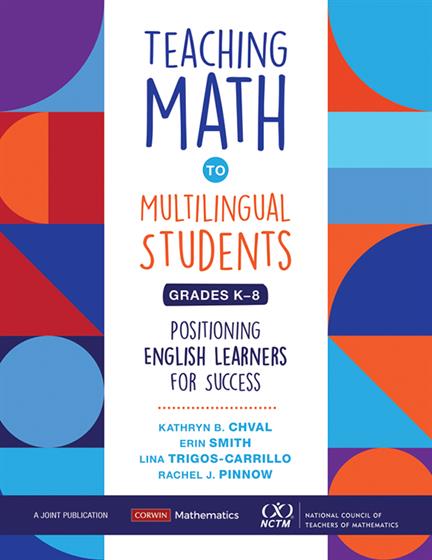
Hands-on, Practical Guidance for Educators
From math,
literacy, equity, multilingual learners, and SEL, to assessment, school counseling,
and education leadership, our books are research-based and authored by experts
on topics most relevant to what educators are facing today.
Teaching Math to Multilingual Students, Grades K-8
- Grade Level: K-8
- ISBN: 9781071810842
- Published By: Corwin
- Series: Corwin Mathematics Series
- Year: 2021
- Page Count: 248
- Publication date: January 21, 2021
Review Copies
Review copies may be requested by individuals planning to purchase 10 or more copies for a team or considering a book for adoption in a higher ed course. To request a review copy, contact sales@corwin.com.
Description
It’s time to re-imagine what’s possible and celebrate the brilliance multilingual learners bring to today’s classrooms. Innovative teaching strategies can position these learners as leaders in mathematics. Yet, as the number of multilingual learners in North American schools grows, many teachers have not had opportunities to gain the competencies required to teach these learners effectively, especially in disciplines such as mathematics. Multilingual learners—historically called English Language Learners—are expected to interpret the meaning of problems, analyze, make conjectures, evaluate their progress, and discuss and understand their own approaches and the approaches of their peers in mathematics classrooms. Thus, language plays a vital role in mathematics learning, and demonstrating these competencies in a second (or third) language is a challenging endeavor.
Based on best practices and the authors’ years of research, this guide offers practical approaches that equip grades K-8 teachers to draw on the strengths of multilingual learners, partner with their families, and position these learners for success. Readers will find:
• A focus on multilingual students as leaders
• A strength-based approach that draws on students’ life experiences and cultural backgrounds
• An emphasis on maintaining high expectations for learners’ capacity for mastering rigorous content
• Strategies for representing concepts in different formats
• Stop and Think questions throughout and reflection questions at the end of each chapter
• Try It! Implementation activities, student work examples, and classroom transcripts
With case studies and activities that provide a solid foundation for teachers’ growth and exploration, this groundbreaking book will help teachers and teacher educators engage in meaningful, humanized mathematics instruction.
Table of Contents
Preface
Acknowledgements
Our Hope for Multilingual Learners
Teachers Who Inspire
Studying Teacher Practice
Interacting With Multilingual Learners and Their Families
Position Multilingual Learners as Classroom Leaders
What Research says About Positioning
Reflecting of Xiao Li's Experience
Reflecting on Nabil Abadi's Experience
Reflecting on José López’s Experience
Positioning Students as Experts
One Year Later
Reflecting on Why Positioning Matters
Recognize How Teachers Position Students
Positioning Multilingual Learners as Leaders
Explicitly Positioning Multilingual Learners as Leaders
Implicitly Positioning Multilingual Learners as Leaders
Strategies for Positioning Multilingual learners as Leaders
Thinking About Positioning in Your Practice
Facilitate Multilingual Learners' Participation in Mathematics Classroom
Reflecting on Your Experience with Participating
What Research Says About Student Participation
Factors That Influence the Participation of Multilingual Learners
Reflecting on Your Experiences with Fear
Overcoming Fear
Encountering Unknown Contexts
Examining Teaching Strategies That Influence Participation
Strategies for Facilitating Multilingual Learners’ Participation in Mathematics
Thinking About Participation in Your Practice
Facilitate Partnerships Between Multilingual Learners and Their Peers
Solving a Mathematics Problem with A Partner
Solving a Mathematics Problem with A Partner
Qualities of Partnerships
Strategies for Facilitating Partnerships
Establish Participation Norms With Students
Practice Compliments
Provide Concrete Resources
Pay Attention To Pairing
Monitor How Partners Work
Revisit Partnership Norms With Student
Thinking About Partnerships in Your Practice
Engage Multilingual Learners Through Culturally-Relevant Contexts
Reflecting on the Challenge of Contexts and Culture
What the Research Says About Contexts in Mathematics
Strategies for Engaging Multilingual Learners Through Culturally-Meaningful Contexts
Thinking about Contexts in your Practice
Reach Multilingual Learners with Visuals, Illustrations, and Gestures
What Research Says About Visuals and Gestures
Using Visuals Strategically
Examining Ms. Bristow’s Use of Visuals: Dividing Cookies
Examining Ms. Bristow’s Use of Visuals: Emphasizing the Meaning of ‘Loose’
Emphasizing Mathematical Connections
Reflecting on Your Use of Gestures
Using Gestures Strategically
Examining Ms. Bristow’s Use of Gestures: Obstacle Course
Examining Ms. Bristow’s Strategic Use of Visuals and Gestures: Columns and Rows
Thinking About Visuals and Gestures in Your Practice
Strategies for Using Visuals and Gestures
Analyze Mathematical Work of Multilingual Learners
Reflecting on Your Experiences
What Research Says About Analyzing Multilingual Learners’ Mathematical Work
What Research Says About Analyzing Multilingual Learners’ Mathematical Work
Analyzing Additional Student Work
Strategies for Discerning Between Mathematical and Language Issues
Examining Abigail’s Work
Examining Janessa’s Work
The Importance of Interviewing Multilingual Learners
Thinking About Analyzing Multilingual Learner’s Mathematical Work in Your Practice
Investigate Meanings to Enhance Multilingual Learners’ Language Development
The Importance of Academic Language for Multilingual Learners
What the Research Says About Academic Language
Distinguishing Between Multiple Meanings of Language
Introducing Specialized Mathematics Language
Amplified Use of Academic Language
Strategies for Enhance Multilingual Learners’ Language Development
Thinking About Academic Language in Your Practice
Use Your Discourse Strategically to Enhance Multilingual Learners’ Opportunity to Learn
Reflecting on Varieties of English that Influence Discourse
What Research Says About Discourse
Teacher Discourse
Connecting Academic Language to Mathematical Representations
Posing Questions to Engage Multilingual Learners
Posing Questions to Engage Multilingual Learners
Strategies for Promoting Classroom Discourse
Thinking About Your Discourse in Your Practice
Foster a Culture of Writing in the Mathematics Classroom
Reflecting on Your Experiences
What Research Says About Writing in Mathematics
Establishing a Need to Write in Mathematics
Establishing a Culture of Writing
Providing Feedback on Students’ Writing
Analyzing Students’ Writing
Strategies for Fostering a Culture of Writing in Your Mathematics Classroom
Reflecting on Mathematical Writing in Your Practice
Develop Writing in Mathematics for Multilingual Learners
Reflecting on Your Practice
Mathematical Genres of Writing
What the Research Says about Mathematical Genres
Identifying Mathematical Writing Genres
Strategies for Developing Writing in Mathematics for Multilingual Learners
Teaching Practices
Activities
Reflecting on Your Use of Mathematical Genres in Your Practice
Enhance Curriculum Materials for Multilingual Learners
Reflecting on Mathematics Curriculum
What Research Says About Curriculum Enhancement for Multilingual Learners
Strategies for Crafting Language to Better Support Multilingual Learners
Analyzing Curriculum Materials for Multilingual Learners
Research Recommendations for Enacting Mathematics Curriculum
Recognizing Different Mathematical Conventions and Representations
Thinking about Mathematical Conventions and Representations in your Practice
Thinking about Curriculum Enhancement in your Practice
Engage with Parents and Families of Multilingual Learners
Reflecting on Your Experiences
What the Research Says about Multilingual Parent and Family Engagement
Multicultural Parenting Styles
Cultural Values
Emphasizing the Value of Family in Your Classroom
Examining Teachers’ and Multilingual Parents’ Expectations
Reframing Multilingual Parental Engagement
Strategies for Facilitating Multilingual Family and Parent Engagement in Your Classroom
Reflecting on Family Engagement in Your Practice
Appendix A. Additional Resources
Appendix B. Selected Solutions
References
Reviews
Kathryn Chval and her colleagues exquisitely give the readers opportunities to see inside a classroom with multilingual students, develop empathy, and deeply understand effective practice. The book’s engaging format provides questions for reflection and strategies to try out, connects research to practice, and compels readers to position students for success.Nora G. Ramirez
This is the book I’ve been waiting for! It is powerful. It brings together often-separate critical ideas for teaching multilingual students and weaves them with in-depth explorations of classrooms. We meet remarkable teachers, whose success we can learn from, which will help us reimagine what’s possible.Lena Licón Khisty
A must-read! This book is an excellent resource to closely examine mathematics instruction that affirms multilingual learners’ identities, competencies, and growth as learners of mathematics. Far too often multilingual children and their families are positioned in deficit ways that lead to limited learning. This book does the opposite. It seamlessly blends practice and research for a comprehensive look at exemplary mathematics teaching that leverages children’s multiple linguistic, cultural, and mathematical strengths. The book offers practical tools and guidance to enhance mathematics instruction, nurture student relationships, and create strong partnerships with families to support and advance multilingual learners in mathematics.Julia Aguirre
Faculty Director of Teacher Credential Programs, School of Education
This book goes beyond the typical support of the academic language of mathematics for English learners. It provides an in-depth perspective on being more culturally inclusive of English learners and allows educators to reflect on their instructional methodologies in mathematics.Alexander L. Tai
Teacher and English Learner Specialist
This book celebrates the brilliance of multilingual learners while also providing evidence-based strategies for teachers. The included cases and activities provide a solid foundation for teachers’ growth and exploration into teaching mathematics with multilingual students. This book will help teachers and teacher educators engage in meaningful and humane mathematics instruction with students.Zandra de Araujo
Associate Professor, College of Education
This inspiring volume provides resources for mathematics teachers to support mathematics learning for English learners. Using four central principles—assets, empathy, practice, and research—to base the strategies and an impressive array of materials, including student work, the volume illustrates multiple approaches to providing English learners with opportunities to learn important mathematics with understanding.Judit Moschkovich
Professor, University of California, Santa Cruz
Teaching Math to Multilingual Students, Grades K–8: Positioning English Learners for Success takes an asset-based approach toward developing multilingual learners in the classroom. This book clearly demonstrates the nuances of analyzing the mathematical work of multilingual learners while providing examples and strategies for giving useful feedback that is applicable to all learners. Fostering a culture of writing in the mathematics classroom is explicitly taught through a variety of strategies, activities, and teacher practices. Topics such as culturally relevant contexts, crafting language, and family involvement serve to round out this text and provide teachers with a solid resource to support multilingual learners in a layered, thoughtful way.Renee Rowan
Second-Grade Teacher
Wondering how to support multilingual learners beyond broad, generic suggestions? This book is it! Through true vignettes, transcripts, pictures, and videos, these authors literally show how to support multilingual learners, while engaging you in developing your own capacities to do so. The chapter on positioning learners as leaders is a must-read for every educator! I can’t wait to use this book in my work with students and teachers.Jennifer Bay-Williams
Author and Professor, University of Louisville
This book is an excellent resource for opening doors of access to mathematics for multilingual students, particularly those multilingual students who are, in the authors’ words, ‘silent spectators’ of classroom lessons. Teaching Math to Multilingual Students, Grades K–8 offers strategies and resources that are both research-based and tried, personalized, and polished in real classrooms. The images from those classrooms are compelling, underscoring the importance of an asset-based mentality in teaching multilingual students.Mark Driscoll
Coauthor of Mathematical Thinking and Communication: Access for English Learners
This book is a must-have for anyone working with multilingual learners in mathematics. The authors push the reader to reflect through questions and prompts and to take action by trying out the strategies suggested. The authors’ deep respect for and asset-based view of multilingual students and their mathematical ideas are evident throughout the whole book. Of particular note is the attention paid to the role of families in the mathematics education of multilingual learners.Marta Civil
Professor of Mathematics Education and Roy F. Graesser Chair–Department of Mathematics
This groundbreaking book offers practical, research-informed strategies and activities that support all learners. Chval and her colleagues’ innovative approach positions multilingual learners as potential classroom leaders in challenging mathematics learning. Even newcomers to English are invited to draw on all their meaning-making resources to participate in the mathematics classroom.Mary J. Schleppegrell
Professor of Education
This book provides a powerful tool for teachers as they engage multilanguage learners in language and mathematics. Each chapter is a wonderful compilation of research and practice that unpacks the strategies that will empower teachers to build upon the unique strengths and knowledge that multilingual students bring to the classroom.Amy Stephens
Senior Program Officer, Board on Science Education, The National Academies of Sciences, Engineering, and Medicine
Review Copies
Review copies may be requested by individuals planning to purchase 10 or more copies for a team or considering a book for adoption in a higher ed course. To request a review copy, contact sales@corwin.com.
Related Resources
- Positioning Multilingual Learners as Leaders [Lessons and Strategies]
- Teaching Strategies That Influence Participation [Lessons and Strategies]





